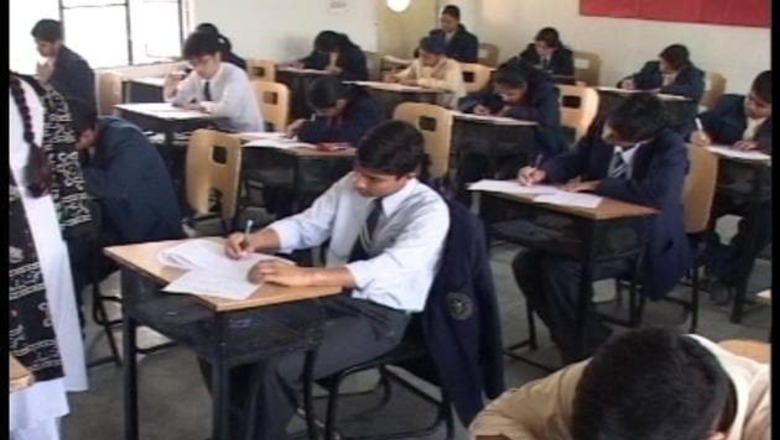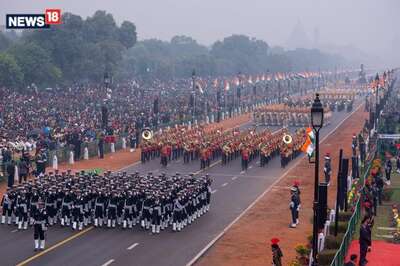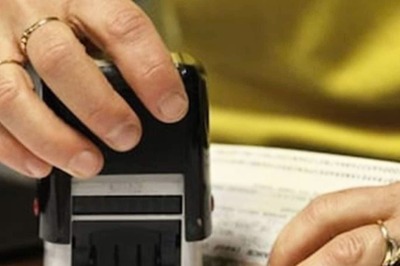
views
This is the mathematics examination paper which CBSE 10th Board examinees had to solve in 2013. Students are advised to try to solve the questions themselves before consulting the solutions. The solutions have been answered by the http://www.topperlearning.com/ faculty.
3. Section A contains 8 questions of 1 mark each, which are multiple choice type question, Section B contains 6 questions of 2 marks each, Section C contains 10 questions of 3 marks each and Section D contains 10 questions of 4 marks each.
4. Use of calculators is not permitted.

Let AB be the tower of height 75 m and C be the position of the car.
In ![]()

Thus, the distance of the car from the base of the tower is ![]() m
m
S = {1,2,3,4,5,6}
Let event E be defined as ’getting an even number’.
n(E) = {1,4,6}
![]()
S = {1, 2, 3,..90}
n(S) = 90
The prime number less than 23 are 2, 3, 5, 7, 11, 13, 17, and 19.
Let event E be defined as ’getting a prime number less than 23’.
n(E) = 8
![]()
Given: AB, BC, CD and AD are tangents to the circle with centre O at Q, P, S and R respectively.
AB = 29 cm, AD = 23, DS = 5 cm and ![]() B = 90o
B = 90o
Construction: Join PQ.

We know that, the lengths of the tangents drawn from an external point to a circle are equal.
DS = DR = 5 cm
![]() AR = AD – DR = 23 cm – 5 cm = 18 cm
AR = AD – DR = 23 cm – 5 cm = 18 cm
AQ = AR = 18 cm
![]() QB = AB – AQ = 29 cm – 18 cm = 11 cm
QB = AB – AQ = 29 cm – 18 cm = 11 cm
QB = BP = 11 cm
In ![]() PQB,
PQB,
PQ2 = QB2 + BP2 = (11 cm)2 + (11 cm)2 = 2 ![]() (11 cm)2
(11 cm)2
PQ = 11 ![]() cm … (1)
cm … (1)
In ![]() OPQ,
OPQ,
PQ2 = OQ2 + OP2 = r2 + r2 = 2r2
(11 ![]() )2 = 2r2
)2 = 2r2
121 = r2
r = 11
Thus, the radius of the circle is 11 cm.
AP ![]() PB (Given)
PB (Given)
CA ![]() AP, CB
AP, CB ![]() BP (Since radius is perpendicular to tangent)
BP (Since radius is perpendicular to tangent)
AC = CB = radius of the circle
Therefore, APBC is a square having side equal to 4 cm.
Therefore, length of each tangent is 4 cm.
From the figure, the coordinates of A, B, and C are (1, 3), (-1, 0) and (4, 0) respectively.
Area of ![]() ABC
ABC

Let r be the radius of the circle.
From the given information, we have:
2![]() r – r = 37 cm
r – r = 37 cm

![]() Circumference of the circle =
Circumference of the circle = ![]()
Common difference =
![]()
Given: ABCD be a parallelogram circumscribing a circle with centre O.
To prove: ABCD is a rhombus.

We know that the tangents drawn to a circle from an exterior point are equal in length.
Therefore, AP = AS, BP = BQ, CR = CQ and DR = DS.
Adding the above equations,
AP + BP + CR + DR = AS + BQ + CQ + DS
(AP + BP) + (CR + DR) = (AS + DS) + (BQ + CQ)
AB + CD = AD + BC
2AB = 2BC
(Since, ABCD is a parallelogram so AB = DC and AD = BC)
AB = BC
Therefore, AB = BC = DC = AD.
Hence, ABCD is a rhombus.
Dimension of the rectangular card board = 14 cm ![]() 7 cm
7 cm
Since, two circular pieces of equal radii and maximum area touching each other are cut from the rectangular card board, therefore, the diameter of each of each circular piece is ![]() = 7 cm.
= 7 cm.

Radius of each circular piece = ![]() cm.
cm.
![]() Sum of area of two circular pieces =
Sum of area of two circular pieces = ![]()
Area of the remaining card board
= Area of the card board – Area of two circular pieces
= 14 cm ![]() 7 cm – 77 cm2
7 cm – 77 cm2
= 98 cm2 – 77 cm2
= 21 cm2
Given: AB = 12 cm, BC = 8 cm and AC = 10 cm.
Let, AD = AF = x cm, BD = BE = y cm and CE = CF = z cm
(Tangents drawn from an external point to the circle are equal in length)
![]() 2(x + y + z) = AB + BC + AC = AD + DB + BE + EC + AF + FC = 30 cm
2(x + y + z) = AB + BC + AC = AD + DB + BE + EC + AF + FC = 30 cm
![]() x + y + z = 15 cm
x + y + z = 15 cm
AB = AD + DB = x + y = 12 cm
![]() z = CF = 15 – 12 = 3 cm
z = CF = 15 – 12 = 3 cm
AC = AF + FC = x + z = 10 cm
![]() y = BE = 15 – 10 = 5 cm
y = BE = 15 – 10 = 5 cm
![]() x = AD = x + y + z – z – y = 15 – 3 – 5 = 7 cm
x = AD = x + y + z – z – y = 15 – 3 – 5 = 7 cm
Three digit numbers divisible by 7 are
105, 112, 119, … 994
This is an AP with first term (a) = 105 and common difference (d) = 7
Let an be the last term.
an = a + (n – 1)d
994 = 105 + (n – 1)(7)
7(n – 1) = 889
n – 1 = 127
n = 128
Thus, there are 128 three-digit natural numbers that are divisible by 7.

Let E be the event that the drawn card is neither a king nor a queen.
Total number of possible outcomes = 52
Total number of kings and queens = 4 + 4 = 8
Therefore, there are 52 – 8 = 44 cards that are neither king nor queen.
Total number of favourable outcomes = 44
![]() Required probability = P(E) =
Required probability = P(E) = ![]()

Let the radius and height of cylinder be r cm and h cm respectively.
Diameter of the hemispherical bowl = 14 cm
![]() Radius of the hemispherical bowl = Radius of the cylinder = r
Radius of the hemispherical bowl = Radius of the cylinder = r ![]()
Total height of the vessel = 13 cm
![]() Height of the cylinder, h = 13 cm – 7 cm = 6 cm
Height of the cylinder, h = 13 cm – 7 cm = 6 cm
Total surface area of the vessel = 2 (curved surface area of the cylinder + curved surface area of the hemisphere)
(Since, the vessel is hollow)
![]()
= 1144 cm2

Height of the cylinder, h = 10 cm
Radius of the cylinder = Radius of each hemisphere = r = 3.5 cm
Volume of wood in the toy = Volume of the cylinder – 2 ![]() Volume of each hemisphere
Volume of each hemisphere

Radius = 21 cm
The arc subtends an angle of 60o at the centre.
(i) l = ![]()

(ii) ![]()
![]()
= 231 cm2
AB and CD are the diameters of a circle with centre O.
![]() OA = OB = OC = OD = 7 cm (Radius of the circle)
OA = OB = OC = OD = 7 cm (Radius of the circle)
Area of the shaded region
= Area of the circle with diameter OB + (Area of the semi-circle ACDA – Area of ![]() ACD)
ACD)


Let the y-axis divide the line segment joining the points (-4,-6) and (10,12) in the ratio k: 1 and the point of the intersection be (0,y).
Using section formula, we have:

Thus, the coordinates of the point of division are ![]()

Let AB and CD be the two poles, where CD (the second pole) = 24 m.
BD = 15 m
Let the height of pole AB be h m.
AL = BD = 15 m and AB = LD = h
So, CL = CD – LD = 24 – h
In ![]() ACL,
ACL,

Thus, height of the first pole is 15.34 m.
(k + 4)x2 + (k + 1)x + 1 = 0
a = k + 4, b = k + 1, c = 1
For equal roots, dicriminant, D = 0
![]() b2 – 4ac = 0
b2 – 4ac = 0
![]() (k + 1)2 – 4(k + 4)
(k + 1)2 – 4(k + 4) ![]() 1 = 0
1 = 0
![]() k2 + 2k + 1 – 4k – 16 = 0
k2 + 2k + 1 – 4k – 16 = 0
![]() k2 – 2k – 15 = 0
k2 – 2k – 15 = 0
![]() k2 – 5k + 3k – 15 = 0
k2 – 5k + 3k – 15 = 0
![]() k(k – 5) + 3(k – 5) = 0
k(k – 5) + 3(k – 5) = 0
![]() (k – 5) (k + 3) = 0
(k – 5) (k + 3) = 0
![]() k = 5 or k = -3
k = 5 or k = -3
Thus, for k = 5 or k = -3, the given quadratic equation has equal roots.
Sn = 3n2 + 4n
First term (a1) = S1 = 3(1)2 + 4(1) = 7
S2 = a1 + a2 = 3(2)2 + 4(2) = 20
a2 = 20 – a1 = 20 – 7 = 13
So, common difference (d) = a2 – a1 = 13 – 7 = 6
Now, an = a + (n – 1)d
![]() a25 = 7 + (25 – 1)
a25 = 7 + (25 – 1) ![]() 6 = 7 + 24
6 = 7 + 24 ![]() 6 = 7 + 144 = 151
6 = 7 + 144 = 151

Steps of construction:
1. Draw two concentric circle with centre O and radii 4 cm and 6 cm. Take a point P on the outer circle and then join OP.
2. Draw the perpendicular bisector of OP. Let the bisector intersects OP at M.
3. With M as the centre and OM as the radius, draw a circle. Let it intersect the inner circle at A and B.
4. Join PA and PB.
Therefore, ![]() are the required tangents.
are the required tangents.
The given points are A(-2,3) B(8,3) and C(6,7).
Using distance formula, we have:
AB2 = ![]()
![]() AB2 = 102 + 0
AB2 = 102 + 0
![]() AB2 = 100
AB2 = 100
BC2 = ![]()
![]() BC2 = (-2)2 + 42
BC2 = (-2)2 + 42
![]() BC2 = 4 + 16
BC2 = 4 + 16
![]() BC2 = 20
BC2 = 20
![]()
![]() CA = (-8)2 + (-4)2
CA = (-8)2 + (-4)2
![]() CA2 = 64 + 16
CA2 = 64 + 16
![]() CA2 = 80
CA2 = 80
It can be observed that:
BC2 + CA2 = 20 + 80 = 100 = AB2
So, by the converse of Pythagoras Theorem,
![]() ABC is a right triangle right angled at C.
ABC is a right triangle right angled at C.
Diameter of circular end of pipe = 2 cm
![]()
![]() of circular end of pipe =
of circular end of pipe = ![]()
Area of cross-section = ![]()
Speed of water = 0.4 m/s = 0.4 ![]() 60 = 24 metre/min
60 = 24 metre/min
Volume of water that flows in 1 minute from pipe = ![]()
Volume of water that flows in 30 minutes from pipe = 30 ![]()
Radius (r2) of base of cylindrical tank = 40 cm = 0.4 m
Let the cylindrical tank be filled up to h m in 30 minutes.
Volume of water filled in tank in 30 minutes is equal to the volume of water flowed out in 30 minutes from the pipe.

Therefore, the rise in level of water in the tank in half an hour is 45 cm.
The group consists of 12 persons.
![]() Total number of possible outcomes = 12
Total number of possible outcomes = 12
Let A denote event of selecting persons who are extremely patient
![]() Number of outcomes favourable to A is 3.
Number of outcomes favourable to A is 3.
Let B denote event of selecting persons who are extremely kind or honest.
Number of persons who are extremely honest is 6.
Number of persons who are extremely kind is 12 – (6 + 3) = 3
![]() Number of outcomes favourable to B = 6 + 3 = 9.
Number of outcomes favourable to B = 6 + 3 = 9.
(i)
![]()
(ii)
![]()
Each of the three values, patience, honesty and kindness is important in one’s life.
Diameter of upper end of bucket = 30 cm
![]() Radius (r1) of upper end of bucket = 15 cm
Radius (r1) of upper end of bucket = 15 cm
Diameter of lower end of bucket = 10 cm
![]() Radius (r2) of lower end of bucket = 5 cm
Radius (r2) of lower end of bucket = 5 cm
Slant height (l) of frustum
= ![]()

Area of metal sheet used to make the bucket

![]()
Cost of 100 cm2 metal sheet = Rs 10
Cost of 545 ![]() cm2 metal sheet
cm2 metal sheet
= Rs.![]()
Therefore, cost of metal sheet used to make the bucket is Rs 171.13.
Given: l and m are two parallel tangents to the circle with centre O touching the circle at A and B respectively. DE is a tangent at the point C, which intersects l at D and m at E.
To prove: ![]()
Construction: Join OC.
Proof:

![]()
OA = OC (Radii of the same circle)
AD = DC (Length of tangents drawn from an external point to a circle are equal)
DO = OD (Common side)
![]() (SSS congruence criterion)
(SSS congruence criterion)
![]() … (1)
… (1)
![]()
![]() … (2)
… (2)
Now, AOB is a diameter of the circle. Hence, it is a straight line.
![]()
From (1) and (2), we have:
2![]() COD + 2
COD + 2![]() COE = 180o
COE = 180o
![]()
Hence, proved.
Let the sides of the two squares be x cm and y cm where x > y.
Then, their areas are x2 and y2 and their perimeters are 4x and 4y.
By the given condition:
x2 + y2 = 400 … (1)
and 4x – 4y = 16
![]() 4(x – y) = 16
4(x – y) = 16 ![]() x – y = 4
x – y = 4
![]() x = y + 4 … (2)
x = y + 4 … (2)
Substituting the value of x from (2) in (1), we get:
(y + 4)2 + y2 = 400
![]() y2 + 16 + 8y + y2 = 400
y2 + 16 + 8y + y2 = 400
![]() 2y2 + 16 + 8y = 400
2y2 + 16 + 8y = 400
![]() y2 + 4y – 192 = 0
y2 + 4y – 192 = 0
![]() y2 + 16y – 12y – 192 = 0
y2 + 16y – 12y – 192 = 0
![]() y(y + 16) – 12 (y + 16) = 0
y(y + 16) – 12 (y + 16) = 0
![]() (y + 16) (y – 12) = 0
(y + 16) (y – 12) = 0
![]() y = -16 or y = 12
y = -16 or y = 12
Since, y cannot be negative, y = 12.
So, x = y + 4 = 12 + 4 = 16
Thus, the sides of the two squares are 16 cm and 12 cm.



Given: A circle with centre O and a tangent XY to the circle at a point P
To Prove: OP is perpendicular to XY.
Construction: Take a point Q on XY other than P and join OQ.
Proof: Here the point Q must lie outside the circle as if it lies inside the tangent XY will become secant to the circle.
Therefore, OQ is longer than the radius OP of the circle, That is, OQ > OP.
This happens for every point on the line XY except the point P.
So OP is the shortest of all the distances of the point O to the points on XY.
And hence OP is perpendicular to XY.
Hence, proved.
Given AP is -12, -9, -6, …, 21
First term, a = -12
Common difference, d = 3
Let 21 be the nth term of the A.P.
21 = a + (n – 1)d
![]() 21 = -12 + (n – 1)
21 = -12 + (n – 1) ![]() 3
3
![]() 33 = (n – 1)
33 = (n – 1) ![]() 3
3
![]() n = 12
n = 12
Sum of the terms of the AP = S12
= ![]()
If 1 is added to each term of the AP, the sum of all the terms of the new AP will increase by n, i.e., 12.
![]() Sum of all the terms of the new AP = 54 + 12 = 66
Sum of all the terms of the new AP = 54 + 12 = 66
Let AC and BD be the two poles of the same height h m.
Given AB = 80 m
Let AP = x m, therefore, PB = (80 – x) m
In ![]() APC,
APC,

In ![]() BPD,
BPD,


Thus, the height of both the poles is ![]() and the distances of the point from the poles are 60 m and 20 m.
and the distances of the point from the poles are 60 m and 20 m.
The given vertices are A(x,y), B(1,2) and C(2,1).
It is know that the area of a triangle whose vertices are (x1, y1), (x2,y2) and (x3, y3) is given by
![]()
![]() Area of
Area of ![]() ABC
ABC

The area of ![]() ABC is given as 6 sq units.
ABC is given as 6 sq units.



















Comments
0 comment